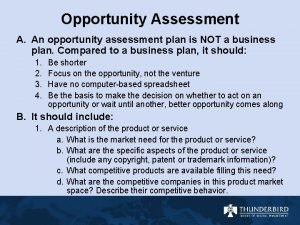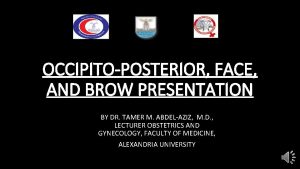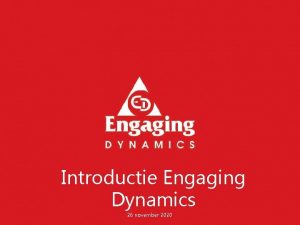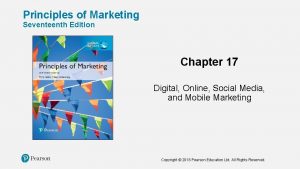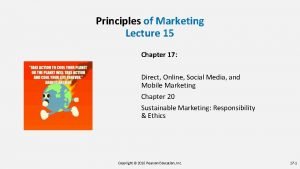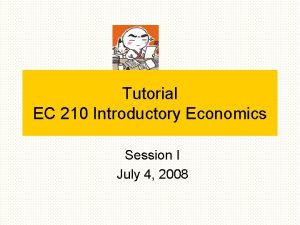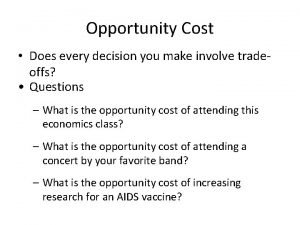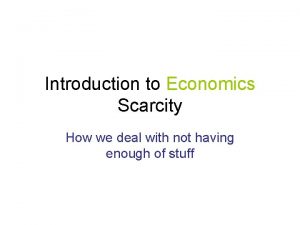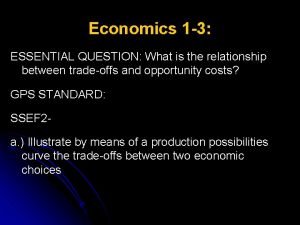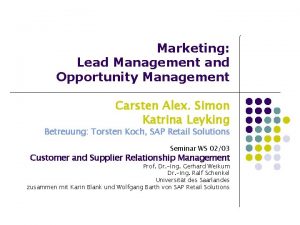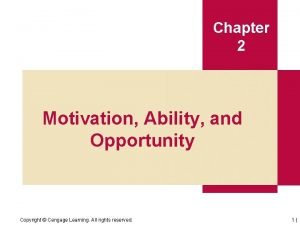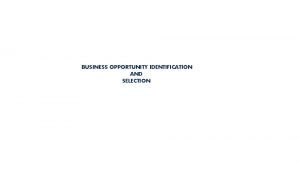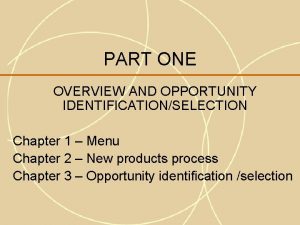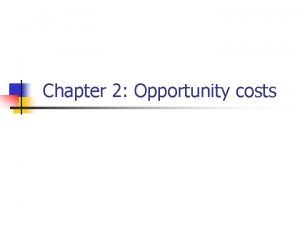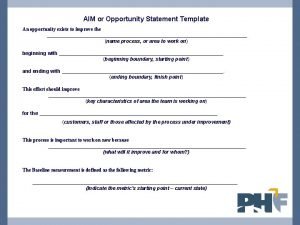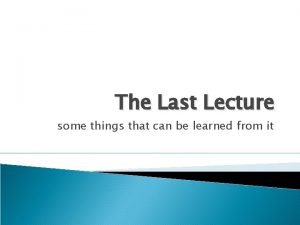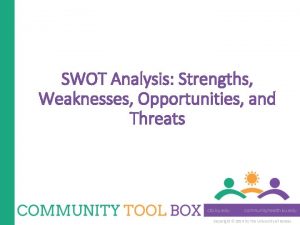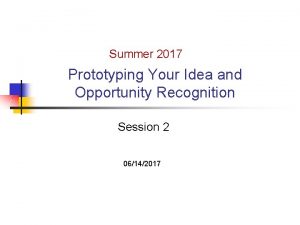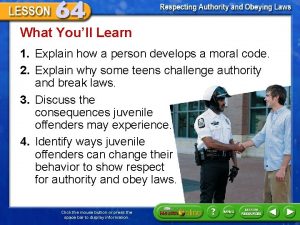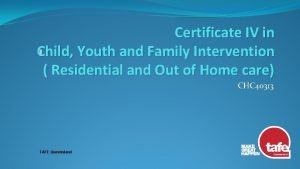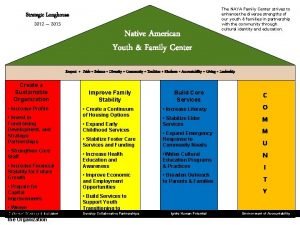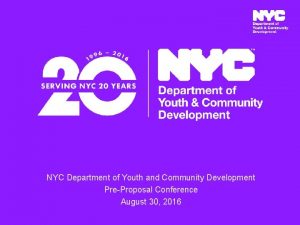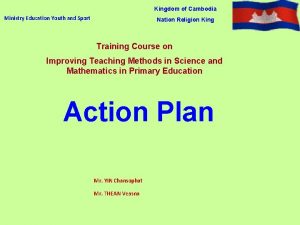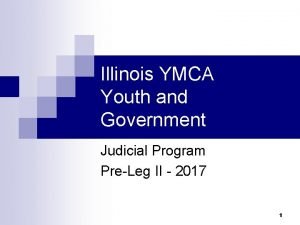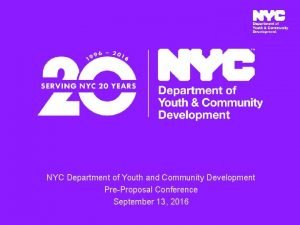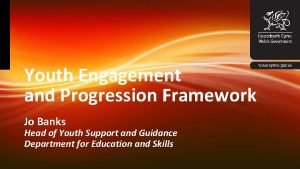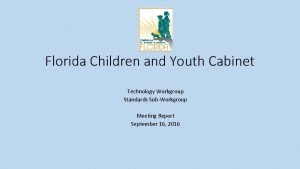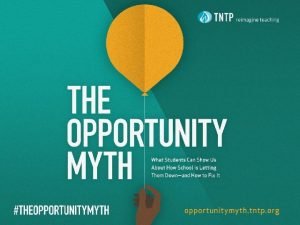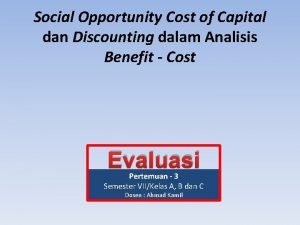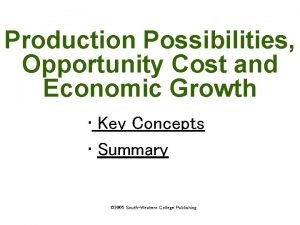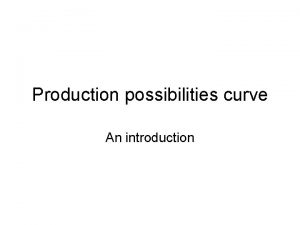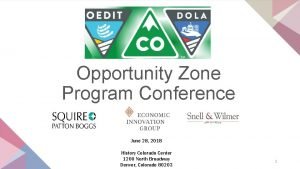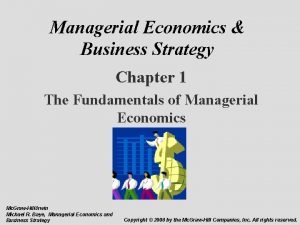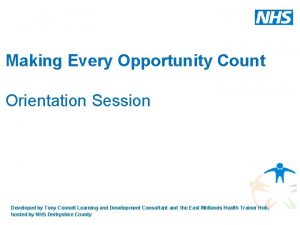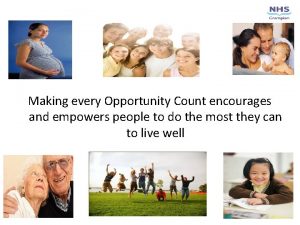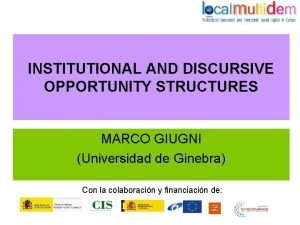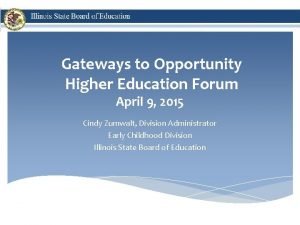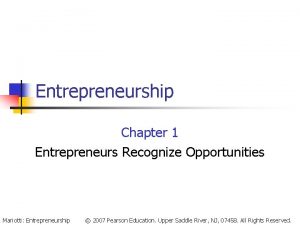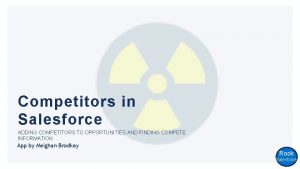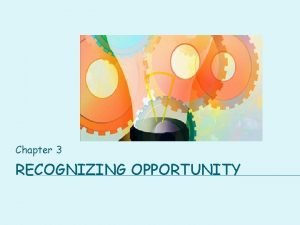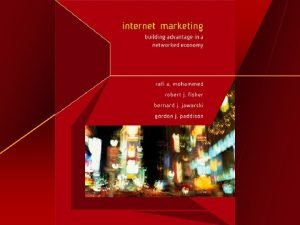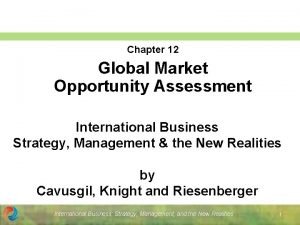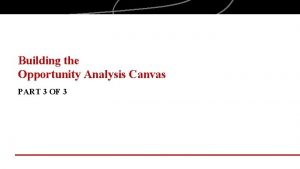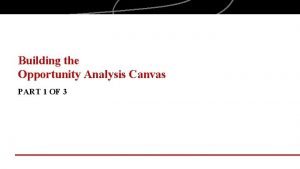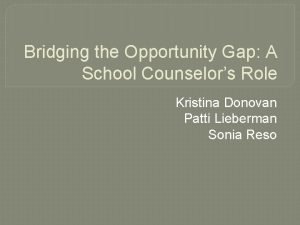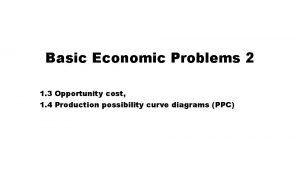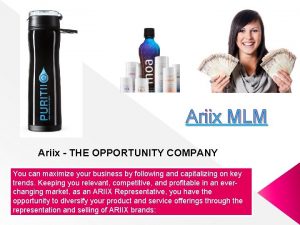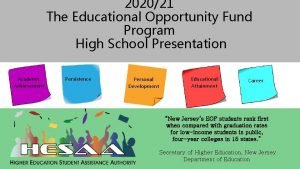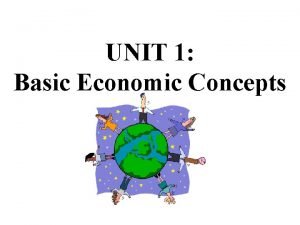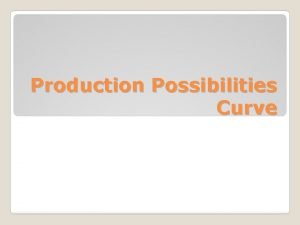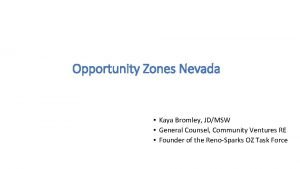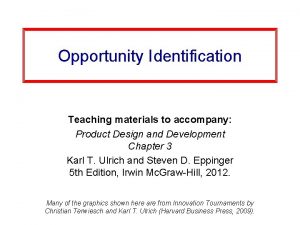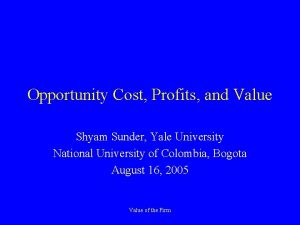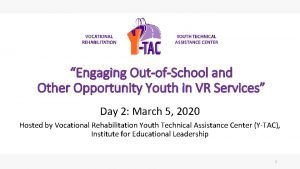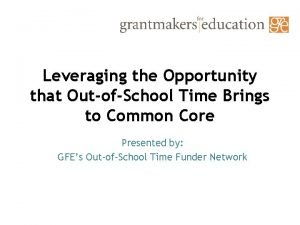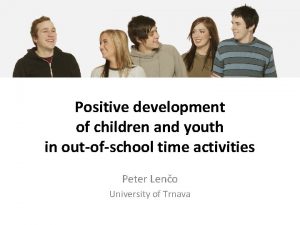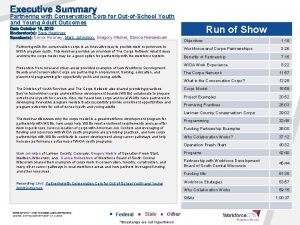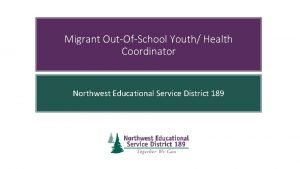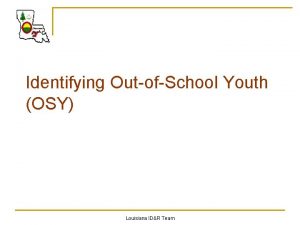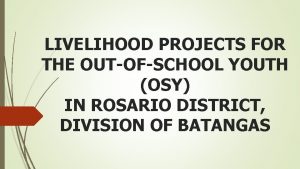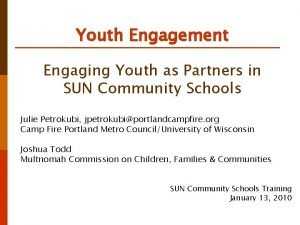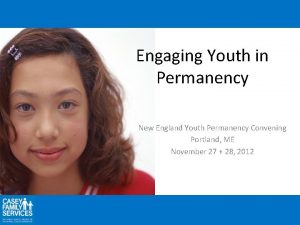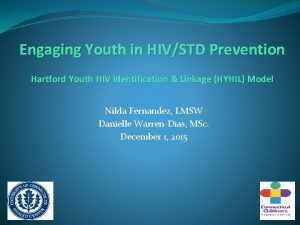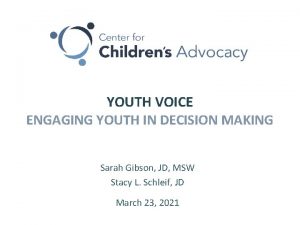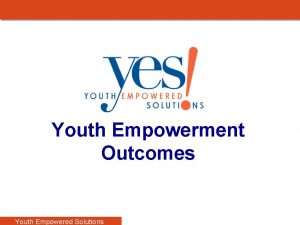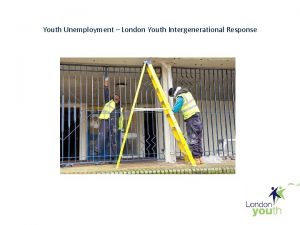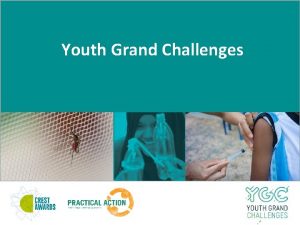Engaging OutofSchool and Other Opportunity Youth in VR














































































- Slides: 78

“Engaging Out-of-School and Other Opportunity Youth in VR Services” Day 1: January 14, 2020 Hosted by Vocational Rehabilitation Youth Technical Assistance Center (Y-TAC), Institute for Educational Leadership 1

The VR Youth Technical Assistance Center (Y-TAC) • Y-TAC provides training and technical assistance to State Vocational Rehabilitation Agencies to help them find and engage youth with disabilities who are not in special education as well as those who are no longer in school and not employed. • Led by the Institute for Educational Leadership (IEL) • In partnership with: • Cornell University’s Yang-Tan Institute on Employment and Disability • Boston University’s School of Education • Key Subject Matter Experts (SMEs) 2

About IEL The Institute for Educational Leadership (IEL) partners with under-resourced communities to equip leaders to better prepare children, youth, adults, and families for postsecondary education and training, rewarding careers, and civic and community engagement. 1. Prepare & support leaders 2. Mobilize 3. Innovate Learn more about IEL at www. iel. org. 3

Convening Purpose & Objectives Attendees will increase their knowledge of: • the experiences of Opportunity Youth with disabilities and common challenges they face in accessing services needed to achieve employment outcomes. • successful strategies for identifying, engaging, and retaining Opportunity Youth with disabilities in services. • strategies for developing collaborative relationships with other agencies and service providers to connect to and effectively serve Opportunity Youth with disabilities. 4

Agenda Day 1 1: 00 pm – Opening Plenary Session: Don’t Dis My Ability: Creating OPPORTUNITY for all YOUTH to thrive 1: 55 pm – Session 1: Tips, Advice, and Innovative Strategies: Navigating Within the Opportunity Youth Space 3: 10 pm – Break 3: 20 pm – Session 2: Recognizing the Diverse Needs of Opportunity Youth & Effective Trauma-Informed Practices to Support Them 4: 50 pm – Closing Remarks 5

Agenda Day 2 1: 00 pm – Recap & Launching A Virtual Network 1: 30 pm – Session 3: Utilizing WIOA to Strengthen Interagency Collaboration 2: 40 pm – Break 2: 50 pm – Session 4: Exploring New Partnerships to Reach Opportunity Youth 4: 00 pm – Break 4: 10 pm – Closing Plenary: Relationally-Focused Engagement of Youth 4: 50 pm – Closing Remarks 6

Participant Norms • Be Present: Stay focused and on topic – time is limited. • Own the Conversation: Participate thoughtfully. Take responsibility for the quality of the discussion. • Be Open Minded: Be open to new ways of thinking. Value everyone’s opinions and ideas. • Share the Air: Let everyone have a chance to speak. Listen while others are talking. • Be Respectful: Seek to understand one another’s views and values. Maintain a positive orientation & presume positive intentions. 7

Reflecting on Sessions • What are the most important ideas/information from the session? • List any resources referenced, but not included in the presentation slides, that you want to look up. • What questions, needs, or challenges has the session inspired you to reflect on in your own work? § What’s an initial step you might take to address each? § Who can you contact as a resource/authority/thought partner in addressing each? 8

Welcome Plenary Speaker Hasan Davis 9

DON’T DIS MY ABILITY Creating OPPORTUNITY for all YOUTH to Thrive Hasan Davis J. D. Former Commissioner, KY Department of Juvenile justice Inaugural Vice Chair Federal Advisory Committee on Juvenile Justice Past Chair, Kentucky Juvenile Justice Advisory Board Website: www. hasandavis. com Twitter: @hasandavis Facebook: HDSolutions #Hope. Dealers

1. What most excites you about working with this opportunity youth population? a) Chance to build relationships and trust b) Chance to use new and share skills c) I’m not quite sure what to expect d) Meh… Poll Questions 2. What concerns if any do you have about this focus? a) How will we measure success b) This will be more time intensive (what about my other work? ) c) This is not what I signed up for d) I think we are going to be OK 3. What kind of skills or new training would you like to have available to ensure your success with this initiative? 11

Cradle to Career Pipeline

school-to-prison pipeline • The "school-to-prison pipeline" refers to the policies and practices that push our nation's schoolchildren, especially our most at-risk children, out of classrooms and into the juvenile and criminal justice systems. This pipeline reflects the prioritization of incarceration over education. (https: //www. aclu. org/factsheet/what-school-prison-pipeline)

Seclusion, Suspension, Arrest, and Referral • 25% of American Indian, Native-Alaskan and African-American boys with disabilities— and nearly 20% girls — receives an out-of-school suspension. • Students with disabilities are 2 x more likely to receive suspension (13%) than students without disabilities (6%). • Students with disabilities represent 12% of student population but • Represent 58% of those placed in seclusion or involuntary confinement, and • 75% of those physically restrained at school to immobilize them or reduce their ability to move freely. • 25% of students arrested and referred to law enforcement. 14

Students with disabilities (IDEA) receiving out-of-school suspensions, by race/ethnicity & gender 15

High School & Post-Secondary Outcomes by 9 th Grade Suspensions

What happens next? Dropouts: • 3 & 1/2 x more likely than high school graduates to be arrested • More than 8 x as likely to experience jail or prison • 63 x more likely to be institutionalized than peers w/ bachelor’s degree or higher.

Over Representation of Youth with Disabilities in the Juvenile Justice System By the numbers… An estimated 70% of justice-involved youth have disabilities, including psychiatric, mental health, sensory, and intellectual disabilities as well as co-occurring disorders. (National Disability Rights Network) 18

Department of Public Safety Office of Justice Programs. Swayze, D. (2013). Minnesota Youth Development Clock, MN

Why does all this matter to me? Because every child has a story… 20

It was quickly made clear my story would be different … Birth: ADHD, Dyslexia, Visual/hearing impairment Kindergarten – 3 rd Grade: Parents divorced, Welfare, Inner city, Family separated, Reunited in GA Grades 4 th through 7 th: Arrested at 11/ probated, Apartment fire age 12, Family separated, Attended 5 different elementary schools, and more than 13 childhood homes Grades 8 th through 12 th: Started alternative school, Expelled from alternative school at 18, and a G. E. D. recipient 21

I still wanted to be greater… But, I could not do it alone…

A different way forward Developing targeted training and education for Service Providers working directly with our Opportunity Youth Population to build the capacity and competencies necessary to be successful coaches, counselors and advocates. 23

Pages from a Hope Dealer’s Notebook: • • • Resist the Madness Act with Faith Allow Time Forgive Failures Deserve Victory

Resist the Madness - Act with Faith - Allow Time - Forgive Failures - Deserve Victory Insanity Principle • If you keep doing what you have always done, you will keep getting what you have always gotten • “If you keep doing what you have always done, your competition will get better and you will get worse results” John Maxwell 25

Resist the Madness - Act with Faith - Allow Time - Forgive Failures - Deserve Victory Faith • Belief – a devotion to, or trust in somebody or something, especially without logical proof. PLUS • Action - the process of doing something, especially when dealing with a problem or difficulty Don’t lower the bar • Students rise or ultimately fall to the highest expectation the world has set for them. 26

List all the places where you think that ability comes before opportunity. Poll Question A. B. C. D. E. Learning a new language Cooking a fancy mean Tuning up a car engine All of thee above The dictionary 27

The only place you will find that Ability comes before Opportunity is in the dictionary! 28

Refuse to allow your office to become a place where dreams go to die. Hospice is not an acceptable substitute for Hope. 29

Resist the Madness - Act with Faith - Allow Time - Forgive Failures - Deserve Victory Being a Hope Dealer requires us nurturing a Growth Mindset “For those who choose this important work, hope is mandatory; You cannot give what we do not possess. ” - Hasan Davis 30

“When is it finally OK for me to just give up? ” 31

Being a Hope Dealer is like wrestling an 800 lb Gator 32

When wrestling an 800 LB gator, there a few rules: 1. You don’t give up when you get tired, 2. You should only give up when the gator is tired, 3. Never, ever believe that a gator is tired. 33

“Treat a man as he is and he will remain as he is” Johann Wolfgang von Goethe

“Treat a man as he can and should be, and he will become as he can and should be. ” Johann Wolfgang von Goethe 35

Final Thoughts • Self care • It is important to develop your own system of emotional and physical self care to protect yourself from the possible impact of Secondary Traumatic Stress (STS) and Compassion Fatigue. 36

Tips, Advice, and Innovative Strategies: Navigating Within the Opportunity Youth Space Y-TAC Virtual Convening Session 1 January 14, 2020 37

Learning Objectives • Collaborative community partnerships best practices • Effective ways to engage Opportunity Youth • Hear from young people the challenges, supports and success with youth serving programs

Presenters • Chuck Beard, Youth Services Specialist/Employment Specialist, Oasis Center in Nashville, TN • Elizabeth Glaser, Youth Service Specialist Peckham, Inc. in Lansing, MI • Wade Grost, Right Turn Program, Peckham, Inc. in Lansing, MI • Thomas Thompson, Right Turn Program, Oasis Center in Nashville, TN • Moderator: Francine Francis, Right Turn Program Director, Institute for Educational Leadership

Polling Question What do you wish Opportunity Youth knew about VR agencies?

Polling Question What do you wish employers or VR agencies knew about OY?

Collaborative Partnerships Transactional • One time/short-term • What you get • Contact with requests • Singular events • Result/goal Relational • Ongoing/long term • What you give • Informed/collaborative • Series of events • Progression/growth

Collaborative Partnerships Transactional • Goal: Recruit and enroll Opportunity Youth Relational Mutually Benefited Activities: • Dual service provider support • Supported employment services • Peer-to-peer referrals • Providing employer needs

Panelist Question What would you say are some strategies on how to effectively collaborate with community agencies?

Panelist Question • What was helpful for you to follow through with the enrollment process into a program? • What motivated you to stay engaged in a program?

Polling Question What are the challenges to recruiting and engaging Opportunity Youth?

Breakout Session You will be assigned to virtual breakout rooms for small group discussions facilitated by your peers. During the discussion, your group will: • Select at least two (or more) recruitment and/or engagement challenges from the generated list. • Identify one or more solutions to each challenge. • Before the end of the discussion, the facilitator will report out by typing at least one challenge discussed and the solutions identified into the Report Out poll available at the bottom left corner of the room. (5 min warning before breakouts end will be issued. )

Share Out! Thank you to our volunteer facilitators for small groups! Via the Report Out poll in your room, you should have done the following: Share one of the recruitment and/or engagement challenges discussed and describe the solutions that were identified.

Q&A Your Questions, Our Answers Visit us: http: //iel. org/rightturn

Evaluation of Session 1 Please take a few minutes to share your feedback on this session. Thank you! 50

10 -Minute Break Up Next… • Session 2: Recognizing The Diverse Needs of Opportunity Youth And Effective Trauma-Informed Practices to Support Them 51

Recognizing The Diverse Needs of Opportunity Youth And Effective Trauma-Informed Practices to Support Them Y-TAC Virtual Convening Session 2 January 14, 2020 52

Session Objectives • Increase awareness of environmental triggers for young people who have experienced trauma • Increase knowledge of effective trauma informed practices to support work and career potential • Understand the importance of including youth voice in all aspects of youth programming 53

Why is Youth Voice Important? 54

What is the National Guard Challe. NGe Program? The mission of The National Guard Youth Challe. NGe Program is to intervene in and reclaim the lives of at-risk youth and produce program graduates with the values, skills, education, and self-discipline necessary to succeed as adults. The vision The National Guard Youth Challe. NGe Program will be recognized as America’s premier voluntary program for 16 to 18 -year-old high school dropouts, serving all U. S. states and territories (https: //www. jointservicessupport. org/NGYCP/, 2020) 55

Panelists Karen Bazan, Freestate Challe. NGe Program, Maryland Muhammed Wishnoff, Freestate Challe. NGe Program, Maryland Christopher Davis, Freestate Challe. NGe Program, Maryland Adene Karhan, LCSW, Yang Tan Institute, Cornell University Officer Kari. Lynn Dunmeyer, Challe. NGe Program Director, Freestate Challe. NGe Program, Maryland Moderator: Karin Grandon MA, CRC, Y-TAC State Technical Assistance Liaison 56

Panel Member Introductions: Graduates: 1. Name 2. Title 3. Dates you were in the program 4. Did you attend more than once? Adene and Kari. Lynn: 1. Name 2. Where and in what capacity do you work with youth who are disconnected? 3. How long have you been working with youth and/or young adults? 57

Panelist Question #1: Stepping into their shoes: • Graduates: Tell us why you chose to be in the Challe. NGe program? • For Adene and Kari. Lynn: Share why you chose to work with youth who are disconnected. 58

Common Trauma Responses Emotional • • • Fear Anxiety Powerlessness Helplessness Worry Anger Physical or Somatic • Nausea • Light headedness • Increased BP • Headache • Stomachache • Increased respiration/heart rate Behavioral • • • (SAMHSA, 2013) Crying Uncooperative Argumentative Unresponsive Restlessness Cognitive • Memory impairment • Inability to give detailed info related to personal history • Forgetfulness • Difficulty concentrating 59

Common Triggers of Trauma Responses Common Triggers • • • Lack of power or control Unexpected change Feeling threatened or attacked Feeling vulnerable or frightened Feeling shame Having to continually re-tell their story • Being seen as a label • No choice in service or treatment (Zelechoski, A. , National Immigrant Justice Center, 2017) 60

Connection Between ACEs & Work Negative Impact of ACEs on Employment Positive Impact of Employment on Healing from ACEs • Compared to those with no ACE’s, those with 4 or more were 2. 5 X more likely to be unemployed and almost 4 X more likely to report being out of work due to sickness or disability. • Work has been found to be a significant factor in rehabilitation after trauma. • Work promotes socially productive behaviors and is a pathway to resilience. (Hardcastle, 2018) (Rosemberg et al. , 2018) 61

Participant Poll #1 Review the items listed, select the top two (2) skills you would most like to develop within your agency/self to help you do your job better: A. Safety: Both physical and emotional B. Trustworthiness: Consistency, interpersonal boundaries C. Choice: Offers a sense of control D. Collaboration: Sharing power E. Empowerment: Recognizes strengths www. SAMHSA. gov 62

Strategies for Providing Trauma-Informed Services to Youth (1) • Create handouts that can be used with individuals such as commonly asked questions about the VR process, agendas for meetings, take-home reminders for next steps, etc. • Create packets of information or brochures that individuals can take home with them about counseling services and other community services • Call individuals periodically to check in, see if they have any questions, and provide encouragement. • Recognize successes with small “celebrations” such as certificates, small rewards, acknowledgement in a newsletter, etc. 63

Strategies for Providing Trauma-Informed Services to Youth (2) • Offer comfortable seating that allows movement, such as exercise/yoga balls, chairs that spin, etc. • Avoid using florescent lights that are uncomfortable for many individuals and can trigger anxiety and panic attacks. • ASK THE YOUTH what works/doesn’t work for her/him. • Avoid using your smart phones, be present. • Develop rapport by being genuine and using counseling techniques, not “shot gun” questions. • Sometimes you have to “meet them where they are” 64

Panelist Question #2 Share a specific example of a situation that triggered one of the trauma responses in you; what did you, or someone who supports you, do to make you feel safe and empowered? 65

Potential Workforce Factors That Can Lead to Re-Traumatization • Social exclusion • Workplace violence • Demeaning work conditions • Prejudice • Unclear job expectations • Lack of control • Excessive workloads • Mistreatment from co-workers/supervisors • Job insecurity (Rosemberg et al. , 2018) 66

Incorporating Trauma-Informed Qualities into VR Service Delivery • Maintaining open and honest communication with clients. • Telling clients what they can expect to happen next in the VR process. • Following through when you say you are going to do something. • Keeping timely appointments or communicating in advance if you can’t attend an appointment or are going to be late. • Providing visual handouts that give an overview of the VR process. • Looking at the individual rather than focusing on completing forms or paperwork during meetings. 67

Qualities Valued in VRC’s A recent study interviewed individuals who were returning to work with the support of a VRC following a PTSD diagnosis. VRC support was viewed as beneficial for the following reasons: • Assisted the individuals in becoming “unstuck” (helped process feelings, create career goals, and make decisions) • Helped individuals become more realistic about finances and financial future • Provided structure and support throughout job search • Gave them a “cheerleader” (Ballou et al. , 2015) 68

Panelist Question #3 1. How do you define “youth voice”? 69

Reflecting on Policies & Procedures (1) • Consider polling some clients to inquire about what the VR process was like for them. What suggestions do they have? • Consider whethere are policies and procedures that could be made more flexible to better meet the needs of clients who have experienced trauma (avoid the “because that’s the way we’ve always done it” mentality). 70

Reflecting on Policies & Procedures (2) • Observe interactions between staff at all levels and the clients that you serve. How are new clients greeted during their initial phone call or their first time entering the building? • Examine the environment with new eyes. Does the lobby/waiting room feel warm and friendly or cold and unfriendly? • Incorporate youth voice in developing and planning systems and programs 71

Terms and Acronyms • • • Trauma Informed Care (TIC) Trauma Informed Methods of Engagement (TIME) Adverse Childhood Experiences (ACEs) The Three “Es”: Event(s), Experience(s), Effect Youth Voice 72

Additional Resources • Y-TAC Website: Y-tac. org • Y-TAC Webinar Recording – Motivational Interviewing with Youth in the VR Setting (Presenter: Adene Karhan) • Institute for Educational Leadership: IEL. org • The Guideposts for Success, National Collaborative on Workforce & Disability for Youth • Research and Training Center for Pathways to Positive Futures, Portland State University • https: //youth. gov/ 73

CONTACT US For more information, contact us at Email: Y-TAC@iel. org Website: https: //y-tac. org Sign up for our Y-TAC Newsletter Follow Y-TAC on Social Media 74

Evaluation of Session 2 Please take a few minutes to share your feedback on this session. Thank you! 75

Day 1 Closing Remarks 76

Agenda Day 2 1: 00 pm – Recap & Launching A Virtual Network 1: 30 pm – Session 3: Utilizing WIOA to Strengthen Interagency Collaboration 2: 40 pm – Break 2: 50 pm – Session 4: Exploring New Partnerships to Reach Opportunity Youth 4: 00 pm – Break 4: 10 pm – Closing Plenary: Relationally-Focused Engagement of Youth 4: 50 pm – Closing Remarks 77

The Y-TAC is a project of the Institute for Educational Leadership, supported by the U. S. Department of Education's Rehabilitation Services Administration. This document was developed by the Vocational Rehabilitation Youth Technical Assistance Center (Y-TAC), funded by a grant/contract/cooperative agreement from the U. S. Department of Education, Rehabilitation Services Administration (Award # H 264 H 150006). The opinions expressed herein do not necessarily reflect the position or policy of the U. S. Department of Education. Nor does mention of trade names, commercial products, or organizations imply the endorsement by the U. S. Department of Education. Note: There are no copyright restrictions on this document. However, please credit the source and support of Federal funds when copying all or part of this document.
 Opportunity
Opportunity Engaging diameter in occipito posterior
Engaging diameter in occipito posterior Dynamisch verbinden
Dynamisch verbinden Marketing involve engaging directly with carefully targeted
Marketing involve engaging directly with carefully targeted Marketing involve engaging directly with carefully targeted
Marketing involve engaging directly with carefully targeted Opportunity youth definition
Opportunity youth definition Types of repair
Types of repair Opportunities of media and information in informational
Opportunities of media and information in informational Trade off definition economics
Trade off definition economics Difference between opportunity cost and trade off
Difference between opportunity cost and trade off For every decision you make, there is a trade-off
For every decision you make, there is a trade-off Opportunity costs def
Opportunity costs def Trade off and opportunity cost
Trade off and opportunity cost Scarcity, choice and opportunity cost example
Scarcity, choice and opportunity cost example Lead and opportunity management
Lead and opportunity management Cengage
Cengage Equal opportunity and the law chapter 2
Equal opportunity and the law chapter 2 Opportunity identification and selection
Opportunity identification and selection Opportunity identification and selection
Opportunity identification and selection Marginal opportunity cost
Marginal opportunity cost Opportunity statement format
Opportunity statement format Thelastlecture.com
Thelastlecture.com Opportunities and threats of a person
Opportunities and threats of a person Opportunity recognition shaping and reshaping
Opportunity recognition shaping and reshaping Asphalt and opportunity
Asphalt and opportunity Opportunity identification and selection
Opportunity identification and selection Why do some youth challenge authority and break laws
Why do some youth challenge authority and break laws Youth is beauty
Youth is beauty Child, youth and family services act, 2017
Child, youth and family services act, 2017 National study of youth and religion
National study of youth and religion Certificate 4 in child youth and family intervention
Certificate 4 in child youth and family intervention Native american youth and family center
Native american youth and family center Red cross youth mission and vision
Red cross youth mission and vision Department of youth and community development
Department of youth and community development Texas youth and government
Texas youth and government Ministry of youth and sports cambodia
Ministry of youth and sports cambodia Illinois ymca youth and government
Illinois ymca youth and government Nyc department of youth
Nyc department of youth Even the youth shall faint
Even the youth shall faint Youth engagement and progression framework
Youth engagement and progression framework London rangers fc
London rangers fc Florida children and youth cabinet
Florida children and youth cabinet Trade-off vs opportunity cost
Trade-off vs opportunity cost Prepaid legal memberships
Prepaid legal memberships Opportunity cost vs trade off
Opportunity cost vs trade off The opportunity myth
The opportunity myth Discount factor adalah
Discount factor adalah Promotion opportunity analysis in imc
Promotion opportunity analysis in imc The law of increasing opportunity costs states that
The law of increasing opportunity costs states that Zero opportunity cost graph
Zero opportunity cost graph Novogradac opportunity zone conference
Novogradac opportunity zone conference Opportunity cost in accounting
Opportunity cost in accounting Every opportunity counts
Every opportunity counts Make every opportunity count
Make every opportunity count Discursive opportunity structure
Discursive opportunity structure Herbalife plan
Herbalife plan Pfa compliance checklist
Pfa compliance checklist Entrepreneurship chapter 1
Entrepreneurship chapter 1 Salesforce opportunity competitors
Salesforce opportunity competitors Chapter 3 recognizing opportunity
Chapter 3 recognizing opportunity New entry in entrepreneurship
New entry in entrepreneurship Framing the market opportunity
Framing the market opportunity International market opportunity
International market opportunity Section 3 opportunity cost
Section 3 opportunity cost Ppf opportunity cost
Ppf opportunity cost The opportunity analysis canvas
The opportunity analysis canvas Opportunity canvas
Opportunity canvas Bridging the opportunity gap
Bridging the opportunity gap Opportunity cost word problems
Opportunity cost word problems George ashton lisc
George ashton lisc Ariix forum
Ariix forum Equal opportunity fund
Equal opportunity fund Sales deal review template
Sales deal review template Opportunity cost problem example
Opportunity cost problem example Law of increasing opportunity cost
Law of increasing opportunity cost Opportunity zones nevada
Opportunity zones nevada An opportunity tournament is a process which:
An opportunity tournament is a process which: Opportunity cost problem example
Opportunity cost problem example Opportunity benefit
Opportunity benefit
